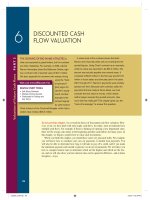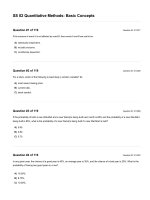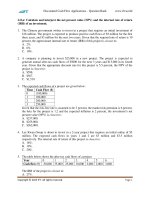CFA 2018 SS 02 reading 07 discounted cash flow applications
Bạn đang xem bản rút gọn của tài liệu. Xem và tải ngay bản đầy đủ của tài liệu tại đây (118.75 KB, 6 trang )
Discounted Cash Flow Applications
2.
NET PRESENT VALUE AND INTERNAL RATE OF RETURN
Capital Budgeting refers to an investment decisionmaking process used by an organization to evaluate
and select long-term investment projects.
Capital Structure is the mix of debt and equity used to
finance investments and projects.
Working capital management refers to the
management of the company’s short-term assets (i.e.
inventory) and short-term liabilities (i.e. accounts
payable).
Capital budgeting usually uses the following
assumptions:
Independent projects are projects whose cash flows are
independent of each other. Since projects are
unrelated, each project is evaluated on the basis of its
own profitability.
Mutually exclusive projects compete directly with each
other e.g. if Projects A and B are mutually exclusive, you
can choose A or B, but you cannot choose both.
2.1
Net Present Value and the Net Present Value Rule
NPV = Present value of cash inflows − initial investment
ܸܰܲ =
1. Decisions are based on cash flows; not on accounting
profits (i.e. net income):
• In addition, intangible costs and benefits are often
ignored because it is assumed that if these benefits
or costs are real, they will eventually be reflected in
cash flows.
• The relevant cash flows need to be considered are
incremental cash flows. Sunk costs should be ignored
in the analysis.
2. Timing of cash flows is critical i.e. cash flows that are
received earlier are more valuable than cash flows
that are received later.
3. Cash flows are based on opportunity costs:
Opportunity costs should be included in project costs.
These costs refer to the cash flows that could be
generated from an asset if it was not used in the
project.
4. Cash flows are analyzed on an after-tax basis. Cash
flows on after-tax basis should be incorporated in the
analysis.
5. Financing costs are ignored. Financing costs are
reflected in the required rate of return which is used to
discount after-tax cash flows and investment outlays
to estimate net present value (NPV) i.e. only projects
with expected return > cost of the capital (required
return) will increase the value of the firm.
• Financing costs are not included in the cash flows;
because when financing costs are included in both
cash flows and in the discount rate, it results in
double-counting the financing costs.
6.
௧ୀଵ
ܨܥ௧
− ܨܥ
ሺ1 + ݎሻ௧
where,
CFt = After-tax cash flow at time t
r
= required rate of return for the investment
CF0 = investment cash outflow at time zero
Decision Rule:
• Accept a project if NPV ≥ 0
• Do not Accept a project if NPV< 0
Independent projects: All projects with positive NPV are
accepted.
Mutually exclusive projects: A project with the highest
NPV is accepted.
• Positive NPV investments increase shareholders
wealth.
• NPV is inversely related to opportunity cost of capital
i.e. the higher the opportunity cost of capital, the
smaller the NPV.
Advantages:
1) NPV directly measures the increase in value to the
firm.
2) NPV assumes that cash flows are reinvested at r
(opportunity cost of capital).
Practice: Example 1,
Volume 1, Reading 7.
Capital budgeting cash flows are not accounting net
income.
For details, refer to Reading 35, Capital Budgeting.s
–––––––––––––––––––––––––––––––––––––– Copyright © FinQuiz.com. All rights reserved. ––––––––––––––––––––––––––––––––––––––
FinQuiz Notes – 2 0 1 7
Reading 7
Reading 7
2.2
Discounted Cash Flow Applications
The Internal Rate of Return and the Internal Rate of
Return Rule
IRR is the discount rate that makes Present value of
future cash inflows = initial investment
• In simple words, IRR is the discount rate where NPV =
0.
• IRR is calculated using trial and error method or by
using a financial calculator.
As the name implies, internal rate of return (IRR) depends
only on the cash flows of the investment i.e. no external
data is needed to calculate it.
FinQuiz.com
Limitations of IRR:
1) IRR is based on the assumption that cash flows are
reinvested at the IRR; however, this may not always
be realistic.
2) IRR provides result in percentages; however,
percentages can be misleading and involves difficulty
in ranking projects i.e. a firm rather earn 100% on a
$100 investment, or 10% on a $10,000 investment.
3) In case of non-conventional cash flow pattern, there
are or can be multiple IRRs or No IRR at all.
Practice: Example 2 & 3,
Volume 1, Reading 7.
Example:
IRR is found by solving the following:
2.3
2500
3000
3500
2000
+
+
+
10,000 =
ሺ1 + ܴܴܫሻଵ ሺ1 + ܴܴܫሻଶ ሺ1 + ܴܴܫሻଷ ሺ1 + ܴܴܫሻସ
4000
+
ሺ1 + ܴܴܫሻହ
Problems with the IRR Rule
No conflict exists between the decision rules for NPV and
IRR when:
1) Projects are independent.
2) Projects have conventional cash flow pattern.
Solution:
IRR = 13.45%
Important to Note:
In the equation of calculating IRR, the IRR must be
compatible with the timing of cash flows i.e. if cash flows
are semi-annual (quarterly), the IRR will be semi-annual
(quarterly).
When project’s cash flows are a perpetuity, IRR can be
estimated as follows:
തതതത
ܨܥ
ܸܰܲ = − ݐ݊݁݉ݐݏ݁ݒ݊ܫ݈ܽ݅ݐ݅݊ܫ+
=0
ܴܴܫ
Decision Rule:
• Accept a project if IRR ≥ Cost of Capital.
• Do not Accept a project if IRR < Cost of Capital.
NOTE:
•
•
•
•
When IRR = opportunity cost of capital NPV = 0.
When IRR> opportunity cost of capital NPV> 0.
When IRR< opportunity cost of capital NPV< 0.
If projects are independent, accept both if IRR of
both projects ≥ Cost of Capital.
• If projects are mutually exclusive and project A IRR >
project B IRR and both IRR ≥ Cost of Capital, accept
Project A because IRRA>IRRB .
Conflict exists between the decision rules for NPV and IRR
when:
1) Projects are mutually exclusive.
2) Projects have non-conventional cash flow pattern.
NPV and IRR rank projects differently due to the following
reasons:
1) Differences in cash flow patterns.
2) Size (scale) differences: Required rate of return favors
small projects because the higher the opportunity
cost, the more valuable these funds are. Sometimes,
the larger, low-rate-of-return project has the better
NPV.
3) Timing differences: Project with shorter payback
period provides more CF in early years for
reinvestment. Therefore, when required rate of return
is high, it favors project with early CFs.
NPV versus IRR:
• NPV rule is based on external market-determined
discount rate because it assumes reinvestment at r
(opportunity cost of capital).
• IRR assumes that cash flows are reinvested at IRR;
thus, IRR and IRR rankings are not affected by any
external interest rate or discount rate.
• It is more realistic to assume reinvestment at
opportunity cost ‘r’; thus, NPV method is the best.
Advantages of IRR:
1)
2)
3)
4)
5)
IRR considers time value of money.
IRR considers all cash flows.
IRR involves less subjectivity.
It is easy to understand.
It is widely accepted.
It implies that whenever there is a conflict between NPV
and IRR decision rule and to choose between mutually
exclusive projects, we should always use NPV rule.
Reading 7
Discounted Cash Flow Applications
3.
PORTFOLIO RETURN MEASUREMENT
Holding Period Return (HPR): A holding period return
refers to the return earned by an investor from holding
an asset for a specified period of time e.g. 1 day, 1
week, 1 month, 5 years etc.
Total return = Capital gain (or loss) yield + Dividend yield
ܲ௧ − ܲ௧ିଵ + ܦ௧ ܲ௧ − ܲ௧ିଵ
ܦ௧
ܴ=
=
+
ܲ௧ିଵ
ܲ௧ିଵ
ܲ௧ିଵ
= ݈݊݅ܽ݃ܽݐ݅ܽܥ+ ݈݀݁݅ݕ݀݊݁݀݅ݒ݅ܦ
ܲ௧ + ܦ௧
−1
=
ܲ
where,
P
D
t-1
t
=
=
=
=
price
dividend
beginning of the period
end of the period
3.1
Money-Weighted Rate of Return
The money-weighted rate of return (MWR) measures the
compound growth rate in the value of all funds invested
in the account over the entire evaluation period. In U.S.,
it is known as “dollar-weighted return”. It represents an
internal rate of return (IRR) of an investment. Like IRR,
• Amounts invested (initial market value of the
portfolio) are cash outflows for the investor.
• All additions to the portfolio are cash outflows for the
investor.
• Amounts returned (receipts) or withdrawn by the
investor are cash inflows for the investor.
• The ending market value of the portfolio is a cash
inflow for the investor.
It is computed as follows:
்
ୀ
FinQuiz.com
ܨܥ
=0
ሺ1 + ܴܴܫሻ௧
where,
IRR represents the MWR.
T = number of periods
CFt = cash flow at time t
• MWR is preferred to use to evaluate the
performance of the portfolio manager when the
manager has discretion over the deposits and
withdrawals made by clients.
Advantages of MWR: MWR requires an account to be
valued only at the beginning and end of the evaluation
period.
Disadvantages of MWR:
• MWR is highly affected by the size and timing of
external cash flows to an account.
• It is not appropriate to use when investment
manager has little or no control over the external
cash flows to an account.
Example:
Assume,
• Amount invested in a mutual fund at the beginning
of 1st year = $100
• Amount invested in a mutual fund at the beginning
of 2nd year = $950
• Amount withdrawn at the end of 2nd year = $350
• Value of investments at the end of 3rd year = $1,270
CF0 = –100
CF1 = –950
CF2 = +350
CF3 = +1,270
ܨܥ
ܨܥଵ
ܨܥଶ
ܨܥଷ
+
+
+
+
ሺ1 + ܴܴܫሻ ሺ1 + ܴܴܫሻଵ ሺ1 + ܴܴܫሻଶ ሺ1 + ܴܴܫሻଷ
−100
−950
+350
=
+
+
ሺ1 + ܴܴܫሻଵ ሺ1 + ܴܴܫሻଶ
1
+1,270
+
=0
ሺ1 + ܴܴܫሻଷ
Solve for IRR, we have → IRR = 26.11%
3.2
Time-Weighted Rate of Return
The time-weighted rate of return (TWR) measures the
compound rate of growth over a stated evaluation
period of one unit of money initially invested in the
account.
• In TWR, the account needs to be valued whenever
an external cash flow occurs.
• TWR measures the actual rate of return earned by
the portfolio manager.
• TWR is preferred to use to evaluate the performance
of the portfolio manager when the manager has no
control over the deposits and withdrawals made by
clients.
When there are no external cash flows, TWR is computed
as follows:
MVଵ − MV
= ܴܲܪr୲ =
MV
In order to calculate time weighted return, first of all,
holding period return for each sub-period is computed
and then these sub-period returns must be linked
together (known as chain-linking process) to compute
the TWR for the entire evaluation period.
Reading 7
Discounted Cash Flow Applications
rtwr = (1+rt,1)×(1+rt,2) × … (1+rt,n) –1
• Note that unless the sub-periods represent a year,
the time-weighted rate of return will not be
expressed as an annual rate.
• Each sub-period return within the full evaluation
period has a weight = (length of the sub-period /
length of the full evaluation period).
FinQuiz.com
Disadvantage of TWR:
• TWR requires determining a value for the account
each time any cash flow occurs.
• Marking to market an account on daily basis is
administratively more cumbersome, expensive and
potentially more error-prone.
Example:
If the investment is for more than one year, timeweighted return can be annualized by calculating
geometric mean of n annual returns:
Time – weighted return = [(1+R1)(1+R2)…(1+Rn)]1/n – 1
• Beginning portfolio value for period 1 = $10,000
• Ending portfolio value for period 1 = $10,050
• Dividends received before additional investment in
period 1 = $100
Where,
Rit = return for year i
n = total number of annual returns
• Beginning portfolio value for period 2 = $10,350
• Ending portfolio value for period 2 = $10,850
• Dividends received in period 2 = $100
Method of computing Time-weighted Return for the Year:
i. Calculate holding period return for each day (i.e. 365
days daily returns) using the following formula:
ݎ =
ୟ୰୩ୣ୲୴ୟ୪୳ୣୟ୲୲୦ୣୣ୬ୢ୭ୢୟ୷୲ିୟ୰୩ୣ୲୴ୟ୪୳ୣୟ୲୲୦ୣୠୣ୧୬୬୧୬୭ୢୟ୷୲
ୟ୰୩ୣ୲୴ୟ୪୳ୣୟ୲୲୦ୣୠୣ୧୬୬୧୬୭ୢୟ୷୲
where,
ri = r1, r2, …r365
ݐ(݁݊݀݅ݎ݁ݎܨℎ݂݁݅ݐ݊݉ݔ݅ݏݐݏݎℎݎ)ݏଵ
10,050 − 10,000 + 100
= 1.50%
=
10,000
ݐ(ݓݐ݀݅ݎ݁ݎܨℎ݁݊݁ݐ݊݉ݔ݅ݏݐݔℎݎ)ݏଶ
10,850 − 10,350 + 100
=
= 5.80%
10,350
The annual return (based on the geometric average)
over the entire period is
ii. Calculate annual return for the year by linking the
daily holding period returns as follows:
r = [(1.0150)(1.05800)] –1=0.0739 or 7.39%
Time – weighted return = [(1+R1)(1+R2)…(1+R365)] – 1
TWR versus MWR:
This annual return represents the precise time-weighted
return for the year IF withdrawals and additions to the
portfolio occur only at the end of day. Otherwise, it
represents the approximate time-weighted return for the
year.
Time-weighted return can be annualized by calculating
geometric mean of n annual returns:
Time-weighted return = [(1+R1)(1+R2)…(1+Rn)]1/n –1
where,
Rit = return in period t
n = total number of periods
Advantage of TWR: TWR is not sensitive to any external
cash flows to the account i.e. additions and withdrawals
of funds.
• When funds are contributed to an account prior to a
period of strong (positive) performance, MWR > TWR.
• When funds are withdrawn from an account prior to
a period of strong (positive) performance, MWR <
TWR.
• When funds are contributed to an account prior to a
period of weak (negative) performance, MWR <
TWR.
• When funds are withdrawn from an account prior to
a period of weak (negative) performance, MWR >
TWR.
• Under normal situations, both TWR and MWR provide
similar results.
• When large external cash flows occur (i.e. > 10% of
account) and during that evaluation period,
account’s performance is highly volatile, then MWR
and TWR will provide significantly different results.
Practice: Example 4 & 5,
Volume 1, Reading 7.
Reading 7
Discounted Cash Flow Applications
4.
MONEY MARKET YIELDS
Money market instruments are short-term debt
instruments i.e. having maturities of one year or less.
These instruments pay par value (face value) at maturity
and are usually discount instruments i.e. they do not pay
coupons, but instead are sold below (at discount from)
their par (face) value. For example, T-bills are discount
instruments where,
• Investor buys the T-bill at (Face value – discount) and
receives face value at maturity.
• Investor earns a dollar return equal to the discount
when he/she holds the T-bill to maturity.
Other types of money-market instruments include
commercial paper and bankers’ acceptances (which
are discount instruments) and negotiable certificates of
deposit (which are interest bearing instruments that pay
coupons).
1) Bank Discount Basis: T-bills are quoted on a 360-day
discount basis rather than price basis using the bank
discount rate (a 360-day year is commonly used in
pricing money market instruments). The bank discount
rate is defined as:
ݎ
360 ܲܽ ݎ− ܲ݁ܿ݅ݎ
=
ܲܽݎ
݊
ܲ ݎܽܲ = ݁ܿ݅ݎቀ1 −
where,
FinQuiz.com
݊ݎ
ቁ
360
rBD = Annualized yield on a bank discount basis
n = Actual number of days remaining to maturity
Limitations of Yield on a bank discount basis: Bank
discount yield is not a meaningful measure of investors’
return because:
Practice: Example 6,
Volume 1, Reading 7.
2) Holding period yield (HPY): HPY reflects the return
earned by an investor by holding the instrument to
maturity.
= ܻܲܪ
ܲଵ − ܲ + ܦଵ
ܲ
where,
P0 = initial purchase price of the instrument
P1 = Price received for the instrument at its maturity
D1 = Cash distribution paid by the instrument at its
maturity (i.e. interest)
For interest-bearing instruments: The purchase and sale
prices must include any accrued interest* when the
bond is purchased/sold between interest payment
dates.
*Coupon interest earned by the seller from the last
coupon date but not received by the seller as the next
coupon date occurs after the date of sale.
NOTE:
• When the price is quoted including accrued interest,
it is called Full price.
• When the price is quoted without accrued interest, it
is called Clean price.
3) Effective annual yield (EAY):
EAY = (I + HPY) 365/t - 1
1.
2.
3.
It is based on the FV (par value) of the bond instead
of its purchase price; but returns should be
evaluated relative to the amount invested (i.e.
purchase price).
It is annualized based on a 360-day year rather than
a 365-day year.
It is annualized based on simple interest; thus, it
ignores the compound interest.
• The discount rate for the T-bill can be used to find PV
of other cash flows with risk characteristics similar to
those of the T-bill.
• However, when risk of cash flows is higher than that
of T-bill, the T-bill's yield can be used as a base rate
and a risk premium is added to it to represent higher
risk of cash flows.
Rule: The bank discount yield < effective annual yield.
4) Money market yield (or CD equivalent yield): Money
market yield can be used to compare the quoted
yield on a T-bill to quoted yield on interest-bearing
money-market instruments that pay interest on a 360day basis.
• Generally, the money market yield is equal to the
annualized holding period yield (assuming a 360-day
year) i.e.
Money market yield = rMM = (HPY) × (360/ t)
• Unlike bank discount yield, the money market yield is
based on purchase price.
࢘ࡹࡹ = (࢘ࡰ ) × ൬
۴ܔܔܑ܊ܡܚܝܛ܉܍ܚ܂܍ܐܜܗ܍ܝܔ܉ܞ܍܋܉
൰
܍܋ܑܚ۾܍ܛ܉ܐ܋ܚܝ۾
Reading 7
Discounted Cash Flow Applications
• Thus, money market yield > bank discount yield.
Or
࢘ࡹࡹ ൌ
360ݎ
360 െ ሺݐሻሺݎ ሻ
5) Bond-equivalent yield: When a semi-annual yield is
annualized by multiplying it by 2, it is referred to as the
bond-equivalent yield. It ignores compounding of
FinQuiz.com
interest. The bond equivalent yield is calculated as
follows:
Bond Equivalent Yield = Semiannual Yield ൈ 2
Practice: Example 7, Volume 1,
Reading 7 & End of Chapter
Practice Problems for Reading 7.









